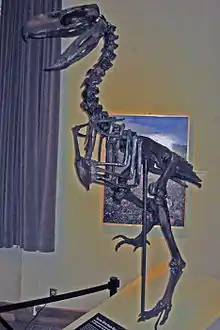Paraphysornis
Paraphysornis is an extinct genus of giant flightless terror birds that inhabited Brazil during Late Oligocene or Early Miocene epochs.[1]
| Paraphysornis | |
|---|---|
 | |
| Reconstructed skeleton | |
| Scientific classification | |
| Kingdom: | Animalia |
| Phylum: | Chordata |
| Class: | Aves |
| Order: | Cariamiformes |
| Family: | †Phorusrhacidae |
| Subfamily: | †Brontornithinae |
| Genus: | †Paraphysornis Alvarenga, 1993 |
| Type species | |
| †Paraphysornis brasiliensis Alvarenga, 1982 | |
| Synonyms | |
| |
Description

Paraphysornis was 2.4 m (7 ft 10 in) tall and weighed approximately 180 kilograms (400 lb). It was calculated at having been around 1.4 m (4 ft 7 in) high at the back.[2] Like Brontornis, Paraphysornis is more massively built than other phorusrhacids and has a shorter and stouter tarsometatarsus, which indicates less cursorial and possibly carrion-feeding habits.[3]
Discovery
The nearly complete (%75) skeleton of one specimen (DGM-1418-R) recovered from the Tremembé Formation of the Taubaté Basin. The specimen only lacks most of the upper maxilla, braincase, pelvis and sternum.[2] In the Museum of Natural History of Taubaté is exposed the almost complete skeleton of Paraphysornis found in 1982 by Herculano Alvarenga.
References
- "Paraphysornis brasiliensis". Fossilworks. Retrieved 2 April 2020.
- Alvarenga, Herculano M. F. & Höfling, Elizabeth (2003). "Systematic revision of the Phorusrhacidae (Aves: Ralliformes)". Papéis Avulsos de Zoologia. 43 (4): 55–91. doi:10.1590/S0031-10492003000400001.CS1 maint: multiple names: authors list (link)
- Mayr, Gerald (2016). Avian Evolution: The Fossil Record of Birds and its Paleobiological Significance (1 ed.). Wiley-Blackwell. p. 192. ISBN 978-1119020769. Retrieved 2 April 2020.
Further reading
- Alvarenga, H.M.F. (1982) Uma gigantesca ave fóssil do cenozóico brasileiro: Physornis brasiliensis sp. n. Anais da Academia Brasileira de Ciências 54(4):697-712
